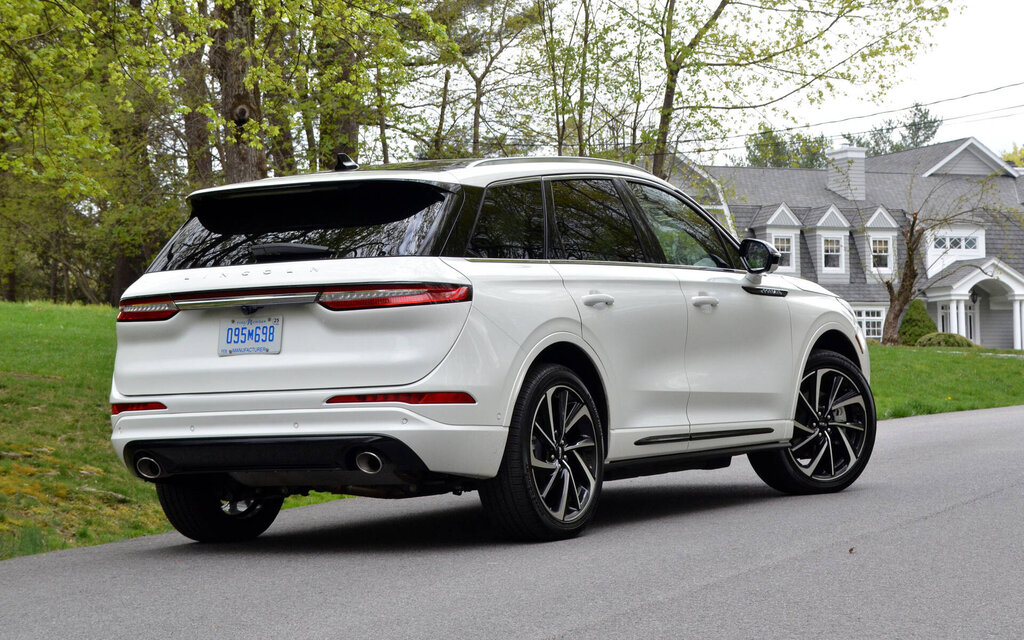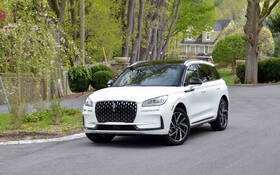2023 Lincoln Corsair Grand Touring: More Tech and a Better Package

| Strong points |
|
|---|---|
| Weak points |
|
The compact luxury SUV segment has never been more populated than it is now, which makes things more difficult for shoppers.
The Lincoln Corsair is based on the popular Ford Escape and uses many of the same components, but you would never know it by looking at them because designers have found a way to really set the two apart.
- Also: 2023 Lincoln Corsair Freshens Up, Adds Hands-Free Tech
- Also: 2022 Lincoln Corsair Grand Touring: PHEV Tech Finally in Lincoln’s Small SUV
New Lincoln Signature
The entry-level Lincoln gets a mid-cycle update for 2023—nothing major but enough to keep potential customers intrigued. Those familiar with the Corsair will recognize the silhouette that’s been part of the lineup since 2020.

The refreshed model stands out with a larger front grille, the one on the Grand Touring plug-in hybrid variant featuring a sundown satin metallic foil with blue accents. There are wing-shaped daytime running lamps and new-look wheels, too. Other than that, it’s business as usual.
Inside, the Lincoln Corsair retains a very linear dashboard, but the centre touchscreen grows to an impressive 13.2 inches and features SYNC 4 infotainment and Lincoln Enhance software updates. A 12.3-inch digital instrument cluster also comes standard for 2023.
The company is offering two new interior themes including classy Smoked Truffle and sporty Eternal Red, the latter accented with exclusive aluminum accents. As for body colours, Crystal Red and Whisper Blue are new additions.

Designers have also cleaned up the control panel below the centre air vents by moving several HVAC functions to the new touchscreen. There’s a bit more space between front-row occupants now.
More Technology Inside
In addition to the fresh HMI, the 2023 Lincoln Corsair takes relaxation behind the wheel to a new level with version 1.2 of the Lincoln ActiveGlide hands-free driver assistance system. Actually, from this point on the system will be called BlueCruise just like the one in Ford vehicles. A smart decision, if you ask us.

Drivers can perform a hands-free lane change when they tap the turn signal, but the system can even suggest a lane change in slow-moving traffic. It will also automatically and smoothly adjust the speed as drivers approach a sharp curve, and keep the Corsair in its lane while subtly shifting it away from vehicles in adjacent lanes—as a normal driver would do in the same situation.
Other new tech features for 2023 include Intersection Assist 2.0, which helps avoid potential collisions with pedestrians while turning, and Blind Spot Assist, which will alert the driver with a light on the side-view mirror and apply a nudge in the steering wheel to help caution against an unsafe action in a case where the driver has missed the previous warnings from the blind spot monitoring system.

While we didn’t experiment with every possible collision scenario, BlueCruise 1.2 stayed on for a good stretch of highway driving during our trip around the New York metropolitan area. While the system didn’t act so smooth on some occasions (and stopped working as we approached a tighter corner), it proved pretty much hassle-free overall.
The display in front of the steering wheel makes it perfectly clear when BlueCruise 1.2 is on and when it is off. Of course, with the heavy traffic in the Big Apple, we erred on the side of caution and remained alert at all times. Whenever our attention veered off the road, the system would demand that we put our two hands back on the wheel.
Ford and Lincoln vehicles are still a long way from driving autonomously, with no intervention from the driver, but for those impossibly dull highway drives (like Toronto to Montreal on Highway 401), Blue Cruise 1.2 can partly take over and reduce fatigue along the way.

Plug-in Hybrid
We got acquainted with the 2023 Lincoln Corsair by test driving the plug-in hybrid variant called Grand Touring. Under the hood is a naturally aspirated 2.5-litre four-cylinder engine paired with an electric motor and 14.4kWh battery. Power is controlled by a CVT and all-wheel drive system as standard, unlike the Ford Escape PHEV which has front-wheel drive only. Lincoln claims a zero-emission range of 43 km, so a bit shorter than most competitors but still enough to meet the daily needs of many drivers.
Starting in downtown NYC, the Corsair Grand Touring took off silently, or so to speak. There’s still that artificial sound at low speeds letting you know you’re driving in pure electric mode. Once the vehicle gets going at a faster clip, you don’t hear a thing. The serene atmosphere inside the cabin is marred only by the noise of the tires on the road.

The four-cylinder engine kicked in one time when we attempted a more spirited passing manoeuvre, but the interior remained remarkably quiet nevertheless. And while we’re no fans of the CVT that quickly revs the engine when stronger acceleration is in order, everything calms down once you’re cruising.
Despite riding on large 20-inch wheels, the 2023 Lincoln Corsair Grand Touring is clearly not the sportiest or sharpest crossover in its class, but we still found it enjoyable. Steering provides just enough feedback to let drivers manoeuvre as they please when the road gets twisty. The comfort-tuned suspension does create a bit of body roll when pushed to the limit. However, given its focus on fuel economy, no one should expect the Corsair to handle like a Ford Mustang.

Speaking of which, Natural Resources Canada (NRC) rates the Corsair Grand Touring at a combined 7.1 L/100 km in hybrid mode, with 43 km of EV range when the battery is fully charged. That’s nearly 50 percent more than the BMW X3 xDrive30e (29 km), by the way.
Yes, the 2023 Model is Better
The update to the Corsair for 2023 is good news for Lincoln dealers that were kind of struggling to find takers for the luxury brand’s smallest SUV. The changes may not be radical, but those new displays inside and available BlueCruise 1.2 are enough to lure technology enthusiasts. Will sales increase? Chances are, yes.











